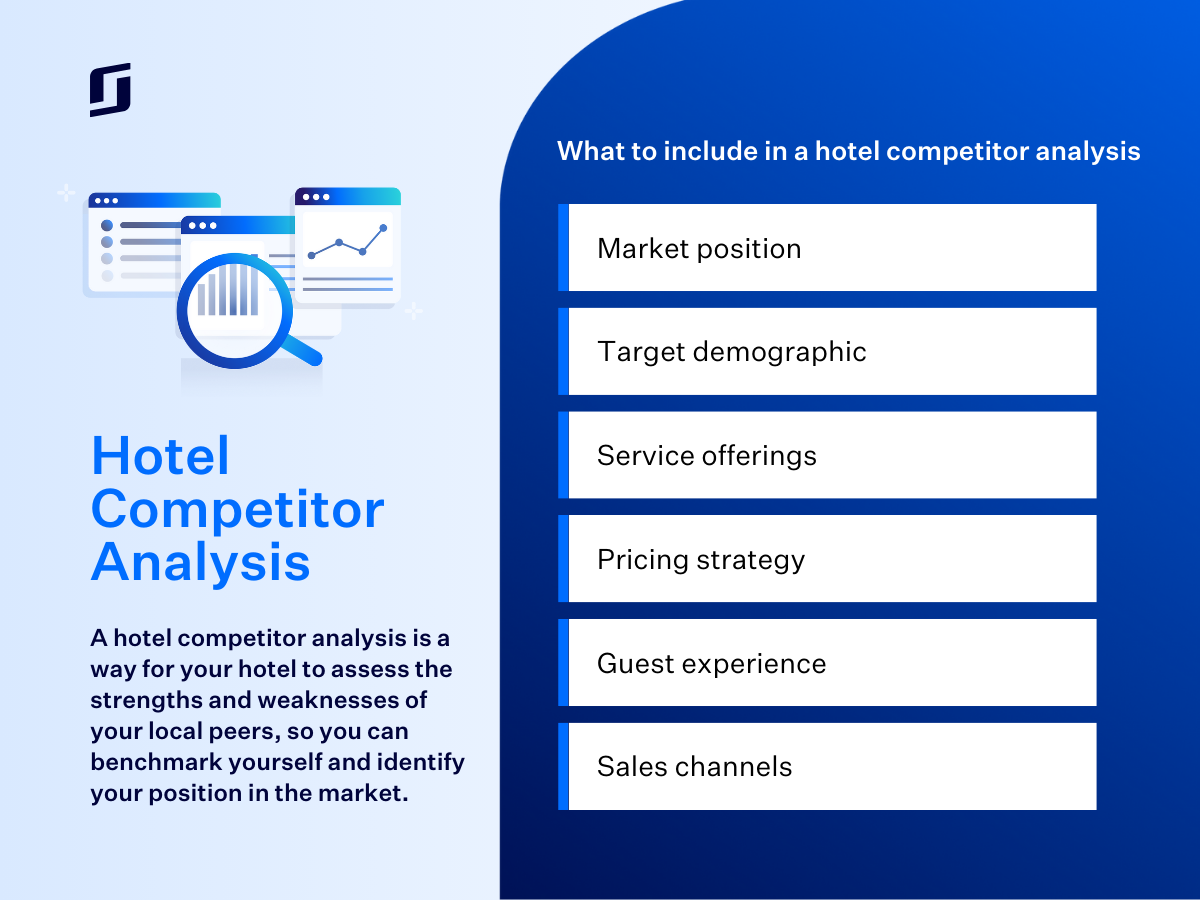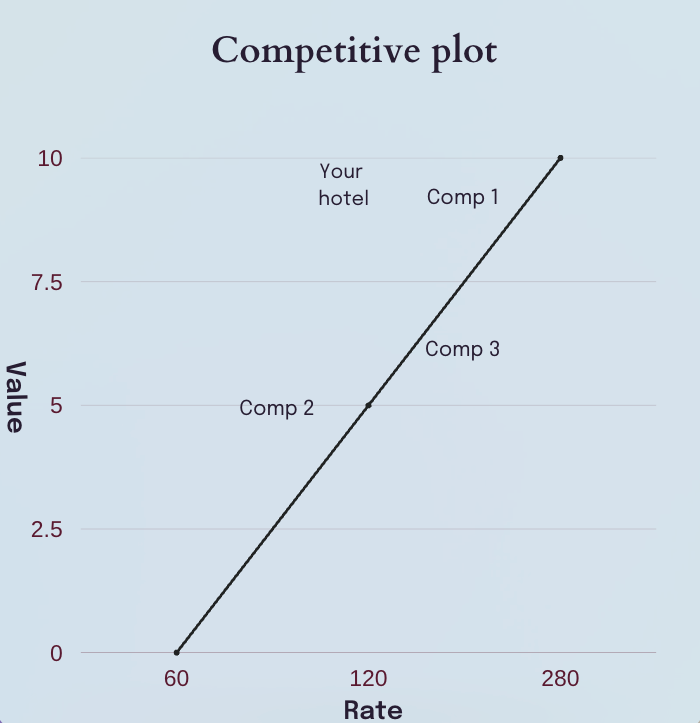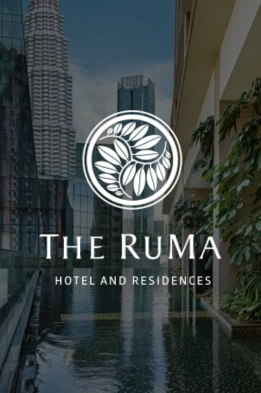What is a hotel competitor analysis?
A hotel competitor analysis is a way for your hotel to assess the strengths and weaknesses of your local peers, so you can benchmark yourself and identify your position in the market.
This allows you to understand if you are pricing your property correctly and make decisions that give you a competitive advantage. This might also mean:
- Creating strategies that make it difficult for new competition to enter the market
- Using guest insights to improve your service above the competition
- Showing you the unique selling points your property should focus on
Using a simple example; if you and a competitor are priced the same but your hotel offers better value and/or quality, you have the opportunity to increase your rates for higher profit.
When it comes to successful revenue management strategy, it’s not just about tracking your own internal metrics such as RevPAR.
At your hotel, you also need to perform regular competitive analysis to see where you stand in the local market and how you can gain an advantage, or at least maximise your potential revenue and profit.
This blog will tell you everything you need to know about hotel competitor analysis.
Table of contents
What is the purpose of competitor analysis for hotels?
A hotel competitor analysis report is one of the most effective ways to reveal both the issues your hotel can fix and the opportunities your hotel can capitalise upon.
While competition in the hotel industry used to be very localised, and hotel analysis was as simple as looking up competitor hotel rates from the businesses around the corner. But the internet has now made competitors of distant hotels, so your business faces more competition than ever. And understanding that competition is the first step to beating that competition.
The strongest hotels rely on data to shape their distribution and marketing strategies and harness it to influence all their major decision-making. The data you decide to focus on is going to make a big difference in the direction your hotel business takes. The key is to find a correlation between data sets, and realising why you’re getting the results you are.
It’s important to filter and ensure the insights you gain are in aid of a consistent purpose and building towards a consolidated brand image for your guests to engage with. Capitalise on competitor insights in real time SiteMinder’s platform delivers real-time insights that ensure you’re always one step ahead of your competition.

Key focus areas of hotel data analysis
These days, hotels need to concentrate their efforts more on understanding the customer on a personal level rather than an occupancy stat or some kind of algorithm.
The reason for this is that consumers now have more power than ever and businesses need to be aware it’s not easy to keep up with growing expectations for service and higher standards for satisfaction.
The digital revolution has been a massive driver for change as far as consumer perspective is concerned. Travellers are now able to pull as much information as they could possibly want on their own, giving themselves more choice and a greater desire for top quality service.
The biggest factor hotels need to take note of is consumer behaviour and guest reviews in as fine detail as possible. Given that 89% of travellers believe reviews are influential to bookings, the goal should be to create a personalised experience for each and every customer based on the data a hotel can glean from them.
It’s been proven that a more personalised form of email marketing can increase open rate by 25%. To achieve this, alternative forms of data collection can be trialled such as staff reporting on their interactions with guests throughout a day or week. Not everything has to be done by numbers.
You can use review data not only to personalise a guest’s experience but to shape your marketing and promotion. If on TripAdvisor you constantly see the location or amenities of your hotel praised, this is what you should strongly push on your social media or website.
Conversely, if you’re seeing some negative comments about value or transaction experience try to keep a low profile until you’ve sorted out the kinks. The difficult and unavoidable issue is that unhappy guests are usually more vocal and extended in their comments, so quality service is at a premium.

What to include in a hotel competitor analysis?
Unearthing useful insights from the vast amount of hotel data at your disposal is always going to be on-going and somewhat time-consuming – but it doesn’t have to be as complicated as it seems.
By focusing your efforts on specific data sets and getting creative with how you use them, data analysis will prove to be an actionable and transformative tool for your hotel.
The overall goal of a competitor analysis is to track patterns at your property and set yourself up to make accurate predictions.
With the right application, you’ll be able to use your data in a variety of ways to make bold plans and prudent adjustments to your pricing strategy.
1. Market position
Hotel competitive set analysis can help you to understand whether you’re positioning your hotel as well as you could – i.e. whether your branding and marketing align with the realities of your business. You could find, for example, that a direct competitor brands itself as a family-friendly option, and gets plenty of business because of it, while you miss out.
2. Target demographic
Further to the above, data analysis can help you to maximise your ability to attract your target customer. Starwood had one of its Caribbean destinations look at weather trends of its core North American customer base and noticed weather patterns greatly affected what travellers were willing to pay. They then structured the system to prompt them when they need to make adjustments.
3. Service offerings
What services do your competitors offer that you don’t? Through competitor analysis hotel industry businesses can identify opportunities for revenue-boosting upsells and add-ons.
4. Pricing strategy
Perhaps the most obvious hotel competitor analysis example is pricing – checking what your competitors are charging for a certain room on certain dates, then ensuring your offer is more compelling.
5. Guest experience
Once you have secured a booking, data analysis can play a critical role in enhancing the guest experience and turning a new customer into a return customer. Denihan, for example, gave its staff smartphones with access to guest analytics so they could better anticipate the needs of guests and better respond to their requests.
6. Sales channels
Which channels drive the most bookings for your hotel? How does your mix compare to that of your competitors? This type of analysis can help you to identify OTAs that you should be listing on, or reinforce the importance of driving more direct bookings.
Integrate to SiteMinder’s vast ecosystem Connect to SiteMinder’s extensive network of technology systems and partners to maximise your efficiency, bookings, and revenue.
How to perform a hotel competitive analysis
There are a few steps to performing your analysis, and all are crucial.
1. Establish your hotel’s competitive set
Your competitive set is who you will compare yourself to. This means you need to correctly identify any hotels that could take business away from yours.
Factors include:
- Proximity – Hotels that are in close geographic proximity to yours, even if they offer a slightly different experience, can be considered competitors. Of course, if you are luxury and they are budget you may discount them.
- Positioning – This refers to the product and experience offered to guests. For example; Budget, Midscale, Upscale, and Luxury to name a few. You should be looking at hotels who position themselves in a similar way to you.
- Price – It makes sense that any hotel with a similar rate structure to your hotel is going to be a competitor.
- Product – Are there hotels near you offering up similar room types and amenities? Add them to your competitive set.
Some other ways you could consider when building a comp-set include looking at target audiences, seasonality, and aspirations. When we say aspirations, it means that if you intend to renovate and upscale your business you should look at who your competitors will be once this is complete.
2. Choose and score competitive attributes
Once you have around four or five competitors to analyse, you need to decide how you will compare everyone.
Examples of what you might assess are price, location, amenities, rooms and features, or reviews.
Next give each characteristic a score out of 10 (or whatever you want to use) for your property and each competitor.
Then, take the average of these scores and plot all the hotels on a graph. It might look something like this:

3. Identify opportunities to adjust your revenue management strategy
You should immediately be able to see who is overpricing and who is underpricing their rooms, and find ways to beat them or at least improve your own performance.
For example, if the highest priced hotel is priced much higher than you but only offering marginally better quality or value, you should be able to raise your rates without losing any bookings. Similarly, if you offer better quality or value, you can price your hotel up to the same rate and still win the lion’s share of bookings – boosting your profit significantly.
Conversely, if you notice that you are being clearly beaten on value, you’ll need to drop your rates to ensure you get enough bookings. You can then try to generate extra revenue from upsells, extras, and other ancillary revenue.
Tips on creating the perfect hotel competitor report
There’s plenty to keep in mind when planning and performing your competitor analysis. Here are some tips that will help you get it right:
- Define some goals along the way – Are you hoping to work on increasing revenue, boosting your guest experience, improving your online reputation, optimising your value, or something else?
- Prioritise some data over others – Work out which data is most important to you when comparing hotels. Reviews are a must, for instance, because they tell you so much from the most important source – the guest. If you’re considering what to include in a competitor analysis, it’s always wise to tie your data to your goals and KPIs.
- Don’t forget to track online activity – Looking at how competitors behave online, such as on social media, will help you further compare your position to theirs. Another online space to look at is what OTA channels they are using, or what keywords they are targeting on Google.
- Don’t overdo it – Try to keep your analysis to under 10 competitors, otherwise it will become overwhelming and confusing, which can make the whole process pointless.
- Don’t set and forget – It’s a good ideal to perform your analysis at the beginning of the financial year, but it can also be a regular process that helps you track demand and keeps you up to date on how your hotel and its competitors are performing.
Strategies to get ahead of your hotel’s competition
So you’ve determined your closest competitors and set your hotel’s price effectively. Now what else can you do to gain an edge?
The local hotel market can often be a fierce battlefield as properties fight to capture a similar type of guest. Maintaining a healthy profit can be very difficult, especially if your destination is highly saturated and your competitors are working just as hard as you to maximise their average daily rate.
You need to find ways to ensure your offering is the best it can be, comparable or superior to similar hotels in the area.
Here are strategies to get you started:
1. Monitor your competitors
SiteMinder found that only 47% of hoteliers actually watch their competitors closely, while 49% were less vigilant, and 3% were not concerned at all. While it’s great to trust your own business plan, part of it must be based on the activity of your competitors.
This means you need to pay attention to their prices and promotions so you can respond in a timely and appropriate manner. For example, if you set a room rate at the same price as your competitors and one at a slightly higher rate, you can still attract deal seekers without completely sacrificing your opportunity for larger revenue.
Here’s how you can keep abreast of your what your competitors are doing:
- Set up alerts and notifications for their rates with a pricing intelligence tool
- Sign up for their emails
- Follow them on social media
- Analyse their SEO and improve your own
2. Use hotel business intelligence tools to stay ‘in the know’
A hotel business intelligence tool gives you real-time market data, including insight into your competitor’s rates. Use this information to always make the right pricing decisions to remain competitive.
3. Work on winning with promotions
Simply comparing your promotions with your competitors’ can give you opportunities to win guests over. For example, if they are offering a two-night discount, could you offer a three-night deal and make the revenue up, plus more, elsewhere over the course of the stay? You can also use your analysis to add value and increase midweek bookings.
4. Listen to your guests
Your guests will usually explicitly list your property’s strengths and weaknesses so you know where you can make improvement. They might even give you a good indication of how you compare to the local competition. Ensure your frontline staff are constantly taking feedback onboard and reporting it back.
The feedback you receive from your guests is extremely important. You need to work hard to secure fantastic online reviews because if you do, you have a justifiable bargaining chip with which to increase your rates.
5. Expand your knowledge and management skills
The more you know about your profession, industry, and local market the easier it will be for you to make successful strategic decisions. There are multiple ways you can become better informed including:
- Catch up regularly with other industry professionals
- Educate yourself on any knowledge gaps
- Subscribe to industry newsletters
- Follow relevant and prominent figures on social media
6. Be introspective about your business
While it’s important to monitor competitors, copying them won’t get you anywhere. Focus on what makes your property special and emphasise this in your marketing to create a point of difference for potential guests.
Maximise your level of service to ensure the travellers you do attract become long-term customers. This will keep your direct bookings high, giving you more revenue and thus flexibility for your rates. Increasing your direct bookings will lower the cost of your distribution and boost your brand awareness.
If a new competitor arrives, resist the urge to immediately match their prices. Their offering may not necessarily be more attractive and if they do bring more travellers to the area you can work on developing plans to capture a slice of their pie.
7. Capture data in real-time
When the market and your competitor’s rates can change at a moment’s notice, you need to be receiving the information you need instantly. With a pricing intelligence tool like SiteMinder’s insight features, this data is immediately available to you.
It also enables you to track competitors and be alerted whenever they make a change to your previously created rules.
With a tool like this you can also perform your own forecasts and predict demand for the local hotel market, meaning the rates you set are more accurate and you won’t lose revenue.
Ultimately, the goal of analysing your hotel alongside competitors is to allow your property to operate in its own perfect niche. You don’t want to become a price follower or mirror your brand to any others, but rather stand out to guests through superior value, service, and authenticity.

